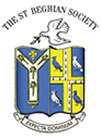|
 |
The Old St Beghian | |
| January 2017 | |||
A MYSTERY NO MORE!
We might suppose that over the years a number of St Beghians have wondered what drove
the Reverend John Dykes to name one of his hymn tunes ST BEES.John Dykes was vicar of St Oswald’s in Durham City during the middle of the nineteenth century. He died in post at the relatively early age of fifty-four in 1871.
The inscription on his gravestone reads Composer of over three hundred hymn tunes.Many of our most loved hymn tunes are credited to Dykes and
are found in the hymn books of virtually every Christian denomination.Recently a dust-covered and mildewed biography of John Dykes was rescued from the vaults of Newcastle’s Central Library.
Scrutiny reveals the story that led to the composition of ST BEES:Dykes acted as choirmaster at St Oswald’s and was in the habit of arriving early to rehearsals,
spending the time ‘doodling’ on the piano.One evening some of the choir members arrived to hear Dykes playing a tune that they were taken with
and said to the Reverend that it should be written down.Dykes did this and decided to call the tune ST BEES because a short while before, he had spent some days visiting
the St Bees Theological College and was very taken with all he saw - liking in particular St Bees Head.The tune is used to accompany a number of hymns but in particular:
Hark, my soul! It is the Lord
‘Tis the Saviour, hear his word.
Jesus speaks, and speaks to me
Say, poor sinner, lov’st thou me?
Image of hymn tune may be seen below:Fingers (FN 57-64)
Home
The St Beghian Society
St Bees School,
St Bees, Cumbria, CA27 0DS.
Tel: (01946) 828093 Email: osb@stbeesschool.co.uk
Web: www.st-beghian-society.co.uk
![]()
 798.jpg)